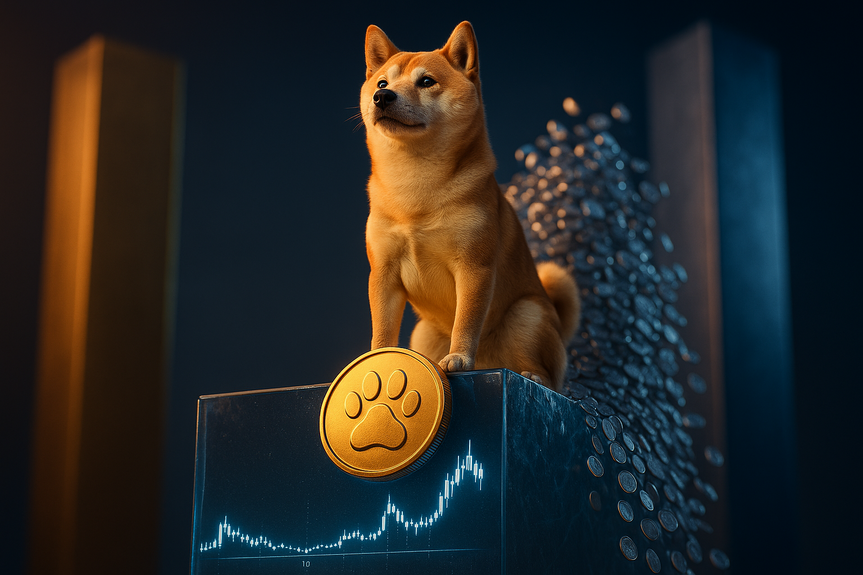is Dogecoin a good investment 2025, or does unlimited supply and niche demand spell long-term risk?
Dogecoin still draws big crowds, but investors should look past the hype. If you wonder is Dogecoin a good investment 2025, focus on its unlimited supply, sentiment-driven price moves, and thin real-world use. It can pump fast, but long-term growth looks weak compared to Bitcoin or Ethereum.
Dogecoin is cheap per coin and easy to buy. It trades around a few cents and sits among the top coins by market cap. The brand is strong. The community is loud. But price does not equal value. Smart investors study supply, demand, and real adoption before they press “buy.”
Is Dogecoin a good investment 2025? Key facts to know
A meme that became a top-10 coin
Dogecoin launched in 2013 as a joke. Two software engineers made it to poke fun at crypto culture. The dog logo went viral, and people used the token for online tips and small payments. Over time, the token gained a loyal online community and broad exchange support.
Today, Dogecoin is one of the largest cryptocurrencies by market value. It is simple. It sends peer-to-peer payments and settles fast with low fees. Some stores accept it. Most people hold it as a speculative bet. Very few businesses run on it.
Supply never stops: 5 billion new DOGE each year
The biggest headwind is supply. Dogecoin has no hard cap. Miners add about 5 billion new DOGE every year. The inflation rate slowly falls as the total supply grows, but the supply still increases forever. This math fights long-term price gains.
Why does this matter? For price to rise and hold, demand must beat new supply. That means fresh buyers must show up year after year at higher prices just to offset the never-ending issuance. That is hard to sustain, especially if utility does not grow.
What actually moves the price
Dogecoin often moves on emotion more than on economics. Viral posts, memes, and celebrity mentions can spark big spikes. The coin can double or halve in days. Macro news, like interest rate cuts, can lift crypto as an asset class, but DOGE usually reacts most to retail sentiment.
By contrast, coins with clear use cases can see steadier demand. Bitcoin now has spot ETFs. Ethereum powers smart contracts and apps. DOGE has fewer institutional buyers and limited enterprise traction. That makes rallies sharp but fragile.
Utility vs. narrative
Dogecoin’s use in the real world is modest. You can send it to a friend, tip a creator, or buy some goods. It is not a smart-contract platform, and it does not anchor a large developer ecosystem. Without a strong roadmap or unique features, it relies more on narrative than on necessity.
This does not make it “bad.” It makes it high beta. In crypto bull runs, DOGE can fly because traders rotate into meme coins after large caps pump. In downtrends, it can fall faster because there is no sticky demand from must-have apps.
How to weigh risk and reward
The bull case in one glance
Strong brand: The Shiba Inu meme is one of crypto’s most famous symbols.
Deep liquidity: Large exchanges list DOGE, making it easy to trade.
Low unit price: New traders feel comfortable buying thousands of coins for a small sum.
Momentum potential: In risk-on markets, DOGE often leads meme rallies.
The bear case that matters more
Unlimited supply: Ongoing issuance puts pressure on long-term price.
Weak utility: Few enterprise use cases; limited development activity compared to leading chains.
Sentiment-driven: Price depends on viral waves that are hard to predict or repeat.
Competition: Many meme coins fight for attention, splitting trader interest.
Who should consider DOGE (and who should not)
Dogecoin suits short-term traders who manage risk well. They accept fast swings and set strict exit plans. They treat DOGE as a trade, not a savings plan.
Dogecoin does not suit conservative investors who want steady compounding. If your goal is long-term wealth, coins with stronger adoption or ETF access usually make more sense.
Position sizing and rules if you still want exposure
Keep it small and structured
Cap your allocation: Consider 0.5% to 2% of your portfolio for high-risk meme coins.
Use dollar-cost averaging: If you buy, spread entries over weeks to reduce timing risk.
Set take-profit targets: Plan partial sales at predefined levels to lock gains.
Place stop-loss orders: Protect the downside, especially during weekend volatility.
Avoid leverage: Volatility plus leverage can erase accounts quickly.
Time your entries wisely
Wait for market structure: Look for higher highs and higher lows on daily charts.
Watch funding and open interest: Frothy derivatives often signal pullbacks.
Track social metrics: Spikes in mentions can mark climaxes rather than safe entries.
Smarter ways to get crypto exposure
Core first, memes second
For most investors, a core crypto position should come before speculative bets. Consider:
Spot Bitcoin ETFs: Easy to hold in a brokerage account; clear custody and reporting.
Ethereum exposure: Many investors view ETH as a long-term bet on decentralized applications.
Crypto infrastructure stocks: Exchanges and service platforms can benefit from volumes without direct token risk. Examples include large, regulated brokerages and public crypto exchanges.
These paths offer simpler tax reporting, better diversification, and lower operational friction than managing multiple wallets and tokens. After building a core, a small satellite in DOGE can be a controlled gamble, not your main thesis.
Key signals to watch in 2025
Macro and liquidity
Interest rates: Lower rates often push investors into risk assets. Crypto tends to benefit, and DOGE can ride the wave.
ETF flows: Strong inflows into Bitcoin ETFs can lift the whole market, but DOGE usually lags leading coins at first.
Adoption and on-chain activity
Merchant acceptance: More real-world payments could support sustained demand, though current traction is small.
Active addresses and transactions: A rising user base can indicate healthier organic demand.
Developer updates: Any credible tech roadmap could improve the long-term view.
Market structure
Dominance shifts: If capital rotates from Bitcoin/Ethereum into altcoins, meme coins often see secondary rallies.
Volatility clusters: High realized volatility often precedes sharp reversals. Use risk controls.
Scenario planning for 2025
Base case: Choppy uptrend, DOGE lags leaders
In a steady but cautious crypto market, Bitcoin and Ethereum may draw most new capital thanks to stronger narratives and institutional on-ramps. DOGE can rise, but spikes may fade fast. Traders must act quickly, while long-term investors may be disappointed by weak follow-through.
Bull case: Risk-on mania, memes rip
If liquidity floods in and social sentiment heats up, DOGE can stage explosive runs. History shows meme coins can post large gains in short windows. The risk: late buyers can be trapped as sharp pullbacks follow blow-off tops.
Bear case: Risk-off and rotating out of speculation
If rates stay high or fear returns, DOGE can fall harder than blue chips. Unlimited supply and weaker use cases offer little protection. Drawdowns can be steep and long.
Answering the big question: is Dogecoin a good investment 2025?
If you ask is Dogecoin a good investment 2025, the honest answer is “not for most long-term investors.” The coin’s unlimited supply, sentiment-driven rallies, and thin real-world use argue against durable compounding. It can be a trade. It is unlikely to be a reliable investment you hold for years.
Still, some people enjoy the community, the meme energy, and the thrill of fast moves. If that is you, treat DOGE as a high-risk satellite. Keep the size small. Define entries and exits. Fund it with profits from stronger core positions rather than new capital you cannot afford to lose.
A balanced strategy for this cycle
Build a core in assets with stronger adoption (for example, Bitcoin through a spot ETF, or Ethereum if you understand the risks).
Use crypto-related equities for diversified exposure to trading volumes and product growth.
Only then, consider a small DOGE allocation if you want meme upside.
Follow a written plan. Review it monthly. Do not chase green candles.
The bottom line: Dogecoin can shine in short bursts, but its structure makes sustained gains difficult. If your goal is long-term wealth, focus on assets with clear utility, growing institutional demand, and better supply dynamics. If your goal is fun and you accept the risks, trade DOGE with discipline. For searchers asking is Dogecoin a good investment 2025, the safer path is to build a core elsewhere and treat Dogecoin as optional, speculative spice—not the main course.
(Source: https://www.fool.com/investing/2025/11/25/is-dogecoin-a-buy-right-now/)
For more news: Click Here
FAQ
Q: What is Dogecoin and how did it start?
A: Dogecoin launched in 2013 as a joke created by two software engineers, and its dog logo went viral. It became a popular token for online tips and small peer-to-peer payments and later gained broad exchange support and a loud community.
Q: How does Dogecoin’s unlimited supply affect its long-term price prospects?
A: Dogecoin has no hard cap and miners add about 5 billion new DOGE each year, so total supply increases forever. That ongoing issuance means demand must continually outpace new supply for prices to rise, which makes durable long-term gains difficult.
Q: What primarily drives Dogecoin’s price movements?
A: Dogecoin’s price is driven more by investor sentiment than fundamentals, with viral posts, memes, and celebrity mentions often sparking big spikes. Macro moves like interest rate cuts can lift crypto broadly, but DOGE usually reacts most to retail sentiment.
Q: Does Dogecoin have practical uses beyond speculation?
A: Its real-world utility is modest: it can be used for peer-to-peer payments, tipping creators, and is accepted at some stores, but few businesses build on it. It is not a smart-contract platform and lacks a large developer ecosystem, so its utility is limited compared with leading chains.
Q: Who might be suited to hold Dogecoin and who should avoid it?
A: Short-term traders who can manage fast swings and set strict exit plans may find DOGE suitable as a trade, while conservative long-term investors seeking steady compounding are generally better off avoiding it. The article recommends treating DOGE as a speculative satellite rather than a core holding.
Q: If I want exposure to Dogecoin, how should I size and manage the position?
A: Keep allocations small—consider 0.5% to 2% of your portfolio—and use dollar-cost averaging to reduce timing risk. Set take-profit targets, place stop-loss orders, and avoid leverage to protect against sharp volatility.
Q: What are smarter ways to get crypto exposure than buying Dogecoin directly?
A: Build a core in assets with stronger adoption first, such as spot Bitcoin ETFs, Ethereum exposure, or crypto infrastructure stocks, which offer simpler tax reporting and diversification. After establishing a core, a small DOGE satellite can be a controlled gamble rather than your main thesis.
Q: So, is Dogecoin a good investment 2025?
A: If you ask is Dogecoin a good investment 2025, the honest answer is that it is not for most long-term investors. Its unlimited supply, sentiment-driven rallies, and thin real-world use argue against durable compounding, though disciplined traders can treat it as a short-term trade.







